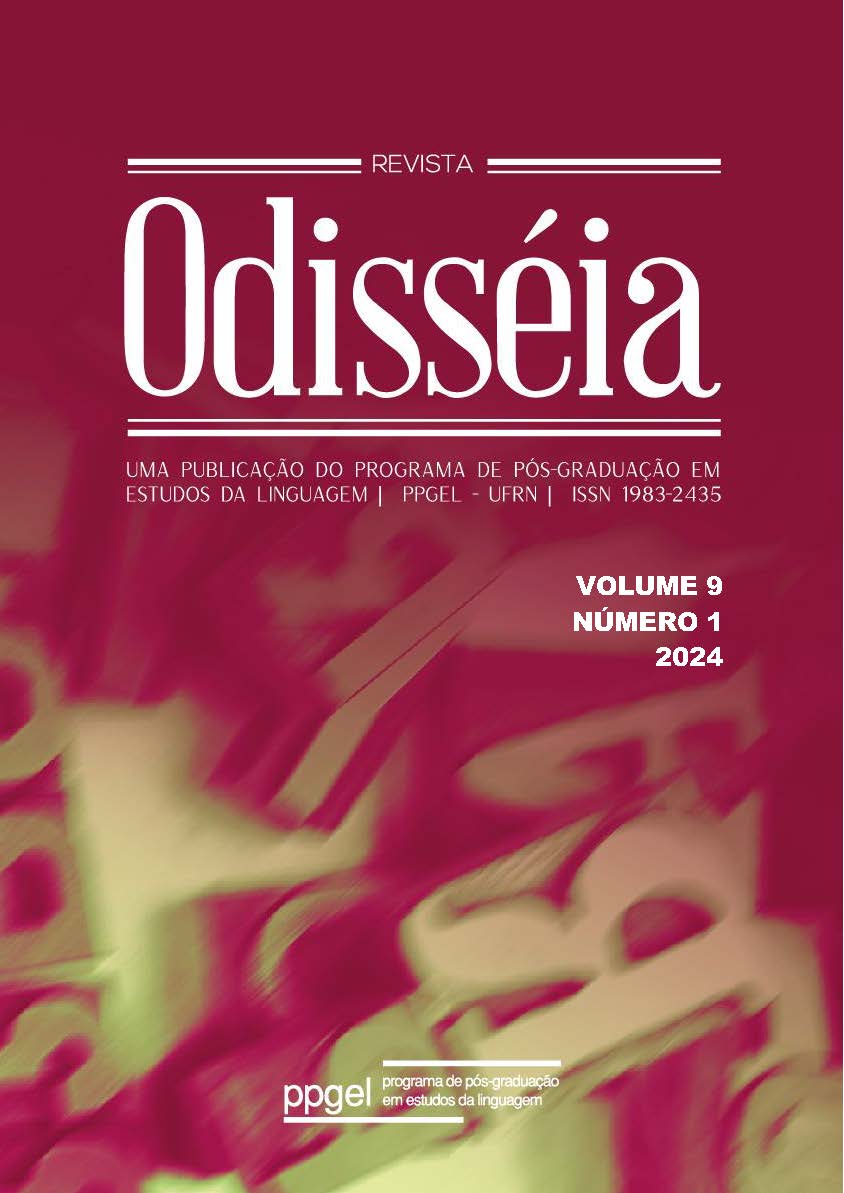Preliminary study on /s/ debucalization in a speech community from Rio Grande do Norte - Brazil
DOI:
https://doi.org/10.21680/1983-2435.2024v9n1ID34404Keywords:
Debucalization, Sociolinguistics, PhonologyAbstract
This paper aims to describe the linguistic and social factors that govern the variation between alveolar and glottal forms of post-vocalic fricative /S/ in the speech of São José de Mipibu City, located in the Brazilian state of Rio Grande do Norte. The analysis is based on the theoretical assumptions of Sociolinguistics (Weinreich, Labov; Herzog, 2006 [1968]; Labov, 2008 [1972]; 1994; 2001) and Autosegmental Phonology (Goldsmith, 1990), specifically on Feature Geometry (Clements; Hume, 1995). The set of data analyzed comes from the project Description of Natural Languages – Portuguese: variant forms of the archiphoneme /S/ in the potiguar speech community. Data on alveolar and glottal realizations of /S/ were subjected to logistic regression models built on the R platform, in order to explain the most productive variables for the analysis of the phenomenon. The results demonstrated that glottal articulation of /S/ is favored by adjacent segments with the feature [+sonorant], in the position of a stressed syllable and in the final syllable of a word in front of a consonant (pattern /V__#C/). There is also evidence that posteriorization may be more productive in the speech of individuals with lower levels of education, in accordance with what the literature already identifies in the description of other communities.
Downloads
References
AULER, M. A difusão lexical num fenômeno de aspiração no português. Revista de Estudos da Linguagem, Belo Horizonte, v. 1, n. 1, p. 43-51, 1992.
CARDOSO, S. A. M. S.; MOTA, J. A.; AGUILERA, V. A.; ARAGÃO, M. S. S.; ISQUERDO, A. N.; RAZKY, A.; MARGOTTI, F. W. Atlas linguístico do Brasil. Londrina: EDUEL, 2014.
CLEMENTS, G. N.; HUME, E. The internal organization of speech sounds. In: GOLDSMITH, J. A. The handbook of phonological theory. Oxford: Blackwell, p. 245-306, 1995.
CUNHA, C. M.; SALES, G. Produção do /S/ pós-vocálico em São José do
Mipibu-RN. Revista do GELNE, Natal, v. 22, n. 2, p. 78-92, 2020.
DIAS DA SILVA, J. J. A debucalização e a teoria fonológica. 2014. 88 f. Dissertação (Mestrado em Linguística) – Universidade Estadual do Sudoeste da Bahia, Vitória da Conquista, 2014.
GOLSMITH, J. A. Autosegmental and Metrical Phonology. Oxford: Basil Blackwell, 1990.
LABOV, W. Principles of linguistic change, volume 1: internal factors. Massachusetts: Wiley-Blackwell, 1994.
LABOV, W. Principles of linguistic change, volume 2: social factors. Massachusetts: Wiley-Blackwell, 2001.
LABOV, W. Padrões sociolinguísticos. São Paulo: Parábola Editorial, 2008 [1972].
LUCCHESI, D. A realização do /S/ implosivo no português popular de Salvador. In: RIBEIRO, S. S. C.; COSTA, S. B. B.; CARDOSO, S. A. M. Dos sons às palavras: nas trilhas da língua portuguesa. Salvador: EDUFBA, 2009. p. 83-110.
LADEFOGED, P. A course in phonetics. New York: Harcourt Brace Jovanovich, 1975.
MOTA, J. A. O -s em coda silábica na norma culta de Salvador. 2002. Tese (Doutorado em Letras Vernáculas) – Faculdade de Letras, Universidade Federal do Rio de Janeiro, Rio de Janeiro, 2002.
OLIVEIRA, E. V. M.; BARBOSA, J. W. A. A influência da nasalização na posteriorização de fricativas vozeadas no dialeto alagoano. Revista Signos, Lajeado, v. 42, n. 2, p. 178-195, 2021
OLIVEIRA, E. V. M.; SANTOS, M. T. R. Variantes sociolinguísticas e a posteriorização das fricativas vozeadas em Alagoas. Filologia e Linguística portuguesa, São Paulo, v. 22, n. 1, p. 41-53, 2020.
PEREIRA, M. N. Atlas geolinguístico do litoral potiguar. 2007. Tese (Doutorado em Letras Vernáculas) – Faculdade de Letras, Universidade Federal do Rio de Janeiro, Rio de Janeiro, 2007.
PESSOA, M. A. F. C. O s pós-vocálico na fala de Natal. In: I Simpósio sobre a Diversidade Linguística no Brasil. Salvador: UFBA, 1986.
R CORE TEAM. R: A language and environment for statistical computing. Versão 4.2.1. Vienna, Austria: R Foundation for Statistical Computing, 2022. Disponível em:
https://www.R-project.org/. Acesso em: 05 jun. 2023.
RONCARATI, C. N.; UCHOA, J. A. C. Enfraquecimento das fricativas sonoras na fala do Ceará. Revista de Letras, n. 33, v. 1, p. 9-50, 2014.
SILVA, M. B. Atlas linguístico do centro-oeste potiguar. 2012. Tese (Doutorado em Linguística) – Departamento de Letras Vernáculas, Universidade Federal do Ceará, Fortaleza, 2012.
WEINREICH, U.; LABOV, W.; HERZOG, M. Fundamentos empíricos para uma teoria da mudança linguística. São Paulo: Parábola Editorial, 2006 [1968].
Downloads
Published
How to Cite
Issue
Section
License
Copyright (c) 2024 Odisseia

This work is licensed under a Creative Commons Attribution-NonCommercial-ShareAlike 4.0 International License.
Thisa work has been licensed under Creative Commons - Atribuição - NãoComercial - CompartilhaIgual 3.0 Não Adaptada.


















